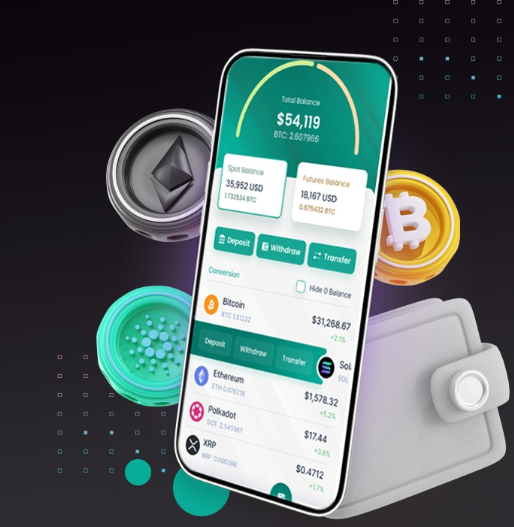A Beginner’s Guide to Crypto Wallet Addresses
- 431 Views
- admin
- 04/13/2025
- Cryptocurrency
In the world of digital currencies, few elements are as essential as the wallet address. Whether you’re sending Bitcoin or receiving Ethereum, understanding how wallet addresses function can help you transact safely and confidently. This guide will walk you through what wallet addresses are, how they work, and what you should know to use them securely.
What Is a Crypto Wallet Address?
A wallet address is the destination used to send and receive cryptocurrency. Think of it like a bank account number, but for blockchain transactions. Every time a crypto transfer occurs, the sender uses the recipient’s wallet address to direct the funds. Each address is generated through a wallet application and is unique to the individual or entity controlling the wallet.
How Bitcoin Wallet Addresses Differ
A Bitcoin address is one of the most common wallet formats. It’s made up of a string of 26 to 35 characters and typically begins with “1”, “3”, or “bc1”. These prefixes indicate the type of address: older Legacy formats, SegWit-compatible types, or the more modern Native SegWit version. Although you can reuse a Bitcoin address, creating a new one for each transaction is considered safer for privacy.
The Mechanics Behind Wallet Addresses
Crypto wallets use cryptographic algorithms to generate two key components: a public key and a private key. Your wallet address is a hashed version of the public key and is used to receive funds. Meanwhile, the private key enables you to authorize transactions, ensuring you have control over the crypto tied to that address.
When sending crypto, your wallet signs the transaction with your private key. This signature is verified across the blockchain network before the transaction is added to the ledger and the funds are moved to the recipient’s wallet.
Components of a Wallet Address
Wallet addresses vary depending on the blockchain they’re built on. Here are a few examples:
- Bitcoin: Usually starts with “1”, “3”, or “bc1”. It can contain up to 35 characters.
- Ethereum: Begins with “0x” and includes 42 alphanumeric characters.
- Litecoin: Typically starts with “L” or “M” and resembles Bitcoin’s structure.
Despite the different formats, all wallet addresses serve the same purpose: to act as the sending or receiving point for crypto transactions.
Common Types of Wallet Addresses
Different blockchain networks and user preferences give rise to multiple wallet address types:
- Legacy (P2PKH): Traditional Bitcoin addresses that begin with “1”.
- SegWit (P2SH): More efficient Bitcoin addresses starting with “3”.
- Native SegWit (Bech32): Begin with “bc1”; they lower fees and improve speed.
- Ethereum Addresses: Consistent across the platform, beginning with “0x”.
- Multi-Signature: Require multiple keys to approve a transaction.
- Vanity: Custom-designed addresses with recognizable patterns.
- Stealth and Wrapped Addresses: Enhance privacy and cross-chain functionality.
- Contract and Change Addresses: Used in Ethereum smart contracts and for managing transaction remainders, respectively.
Each format is optimized for specific features like privacy, scalability, or cross-chain usage.
Creating a Wallet Address
Setting up a wallet address involves a few straightforward steps:
- Choose a Wallet Type: Decide between software, hardware, or paper wallets.
- Set Up the Wallet: Install the software or activate the hardware device.
- Generate an Address: Most wallets offer a button or command to create a new public address.
- Access Your Address: The address will appear in the “Receive” section of your wallet dashboard.
If you’re using a wallet provided by a crypto exchange, the platform usually generates addresses for you automatically. These custodial wallets are easier to manage for trading but offer less control over your private keys.
Locating Your Wallet Address
To find your address, simply open your wallet and head to the “Receive” or “Account” section. For hardware wallets, connect the device to a compatible app. For paper wallets, your address is printed alongside the private key. Always double-check addresses when copying or pasting them to prevent costly mistakes.
Using a Wallet Address for Transactions
Wallet addresses are used in three primary ways:
- Receiving Crypto: Share your address with someone who wants to send you digital assets.
- Sending Funds: Input the recipient’s address into your wallet’s transfer field.
- Checking Balances: Use a blockchain explorer to view a wallet’s history and current holdings by pasting the address into the search bar.
These processes form the foundation of interacting with any cryptocurrency network.
Staying Safe with Your Wallet Address
While it’s safe to share your wallet address, there are important security practices to follow:
- Guard Your Private Key: Never share this. Losing it means losing access to your funds.
- Beware of Phishing Sites: Always double-check the URL of any platform where you enter your wallet information.
- Rotate Addresses: Generating a new address for each transaction enhances privacy by making it harder for observers to track your activity.
Taking these precautions can protect your assets from unnecessary risk.
Closing Thoughts
Grasping the role and structure of wallet addresses is vital for anyone involved in cryptocurrency. Whether you’re investing, trading, or simply learning, knowing how to generate, use, and secure your wallet address will help you manage your assets effectively. As crypto adoption grows, this foundational knowledge becomes even more important for anyone looking to participate safely and smartly in the digital economy.
Recent Posts
- How AI is Revolutionizing Architectural Design: A Look at Tools, Trends, and the Future
- Streamlining Cyber Risk Assessments Through Automation
- Understanding the Difference Between Blockchain and Distributed Ledger Technology
- Is Bitcoin Mining Still a Viable Venture in 2025?
- Exploring AI: Unveiling Possibilities, Challenges, and Future Implications

